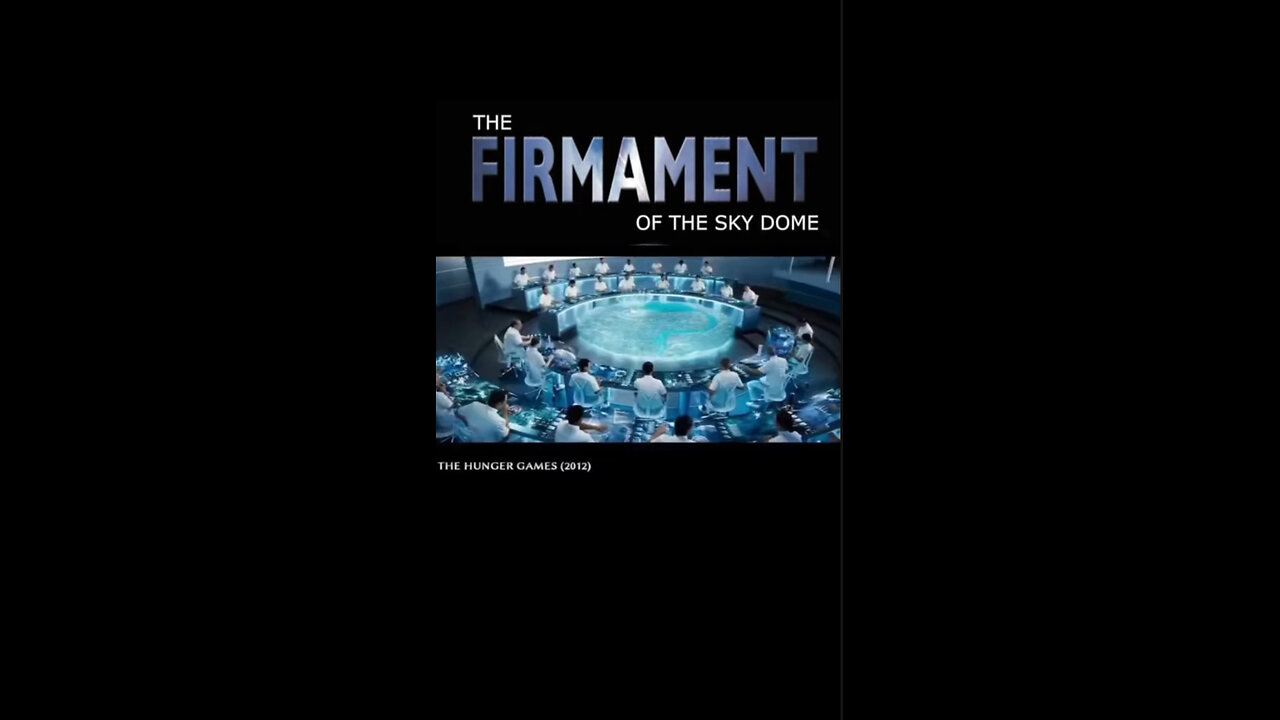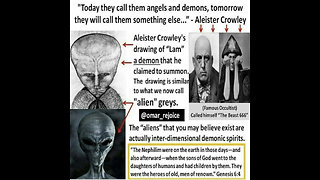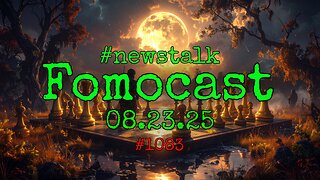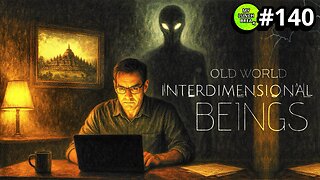Premium Only Content

The Technological Firmament: Unveiling the Mysteries of the Flat Earth
The Flat Earth model, with its concept of a firmament, offers a fascinating and profound perspective on the nature of our world and the universe. Central to this model is the idea of the firmament—a vast, impenetrable dome that encapsulates the Earth. Rooted in ancient texts, scientific anomalies, and modern observations, this theory delves into the intricate and advanced technological structure of the firmament, providing a comprehensive and mind-blowing narrative about our existence.
Responding to the Comment: “Where can we walk up to and touch this ‘solid dome?’”
In the Flat Earth model, the firmament is not a tangible object that one can walk up to and touch. Instead, it is understood as a multifaceted boundary, serving both physical and metaphysical purposes. Here’s an elaborate explanation addressing the nature of the firmament and why it cannot be physically touched:
The Firmament: Beyond a Physical Dome
1. Metaphysical Boundary:
The firmament is considered a boundary between the terrestrial realm and the celestial heavens. It is not a physical object that can be touched but rather a conceptual and metaphysical barrier. This boundary represents the division between the physical world we inhabit and the spiritual or cosmic realm above. It acts as a constant reminder of the divine order and the separation of different planes of existence.
2. Electromagnetic Properties:
The firmament is theorized to be an electromagnetic field or a dynamic layer of charged particles. This field interacts with cosmic and solar radiation, creating a protective shield around the Earth. This electromagnetic firmament bends light and influences the behavior of celestial bodies, making it appear as though stars and planets move in a fixed path across the sky. The firmament’s electromagnetic nature makes it impenetrable with current technology, akin to the Van Allen radiation belts which prevent human travel beyond low Earth orbit.
3. Technological Construct Theory:
Some theories propose that the firmament is an advanced technological structure created by an ancient civilization or extraterrestrial intelligence. This construct could serve multiple purposes, such as:
• Energy Generation: Harnessing cosmic energies to maintain Earth’s electromagnetic balance.
• Cosmic Shield: Protecting the Earth from harmful cosmic radiation.
• Communication Device: Facilitating long-distance communication across Earth or with extraterrestrial entities.
• Virtual Reality Projection: Simulating the sky and celestial bodies, explaining their consistent and predictable patterns.
Integration of Ancient Cosmologies and Modern Science
Ancient Texts and the Firmament
Biblical Descriptions:
• Genesis 1:6-8 (KJV): “And God said, Let there be a firmament in the midst of the waters, and let it divide the waters from the waters. And God made the firmament, and divided the waters which were under the firmament from the waters which were above the firmament: and it was so.”
• Psalm 19:1 (KJV): “The heavens declare the glory of God; and the firmament sheweth his handywork.”
These verses suggest that the firmament is a solid structure that separates waters above from waters below, indicating a protective barrier surrounding the Earth.
Enochian Cosmology:
• Book of Enoch: Enoch describes multiple heavens layered above the firmament, with each level housing various beings and phenomena. The first heaven, directly above the firmament, contains vast bodies of water larger than all Earth’s oceans combined.
Global Mythologies:
• Babylonian Cosmology: The Babylonians envisioned the universe as a flat disk surrounded by a cosmic ocean, with a solid dome (the firmament) above it. This dome was believed to hold back the waters of chaos and was supported by mountains at the edges of the earth.
• Egyptian Cosmology: The ancient Egyptians also had a similar concept, where the sky was a solid dome supported by mountains at the four corners of the earth. The stars were seen as lamps hanging from this dome.
Scientific Anomalies and the Firmament
Operation Fishbowl:
• High-Altitude Nuclear Tests (1962): During Operation Fishbowl, the U.S. government conducted nuclear tests at high altitudes. The stated goal was to study the effects of nuclear explosions in space, but some theorists believe these tests were attempts to breach the firmament.
Van Allen Radiation Belts:
• Radiation Shield: The Van Allen belts are zones of intense radiation that encircle the Earth. Some flat Earth theorists argue that these belts are part of the firmament’s protective structure, preventing human travel beyond low Earth orbit.
The Toroidal Model
The idea that we live on a flat plane within a toroidal (doughnut-shaped) electromagnetic field is another fascinating aspect of the flat Earth theory. This toroidal field is thought to generate a vortex at the center, influencing the movement and behavior of celestial bodies within the firmament. This model explains the observed phenomena of rotating stars and the consistent paths of the sun and moon across the sky.
Electromagnetic Firmament:
The firmament forms from the interaction between the Earth’s inherent electromagnetic properties and external cosmic energies. It is thought to be composed of a plasma-like substance, highly ionized and capable of influencing radio transmissions, weather patterns, and even the behavior of light. This structure bends light traveling towards it, creating unique optical effects and phenomena such as the apparent movement of celestial bodies across the sky.
Philosophical and Existential Implications
Human Significance:
If the firmament is indeed an advanced technological construct, it implies a designed and purposeful creation. This challenges the random and chaotic nature proposed by mainstream cosmology and reinforces the belief in a higher power or advanced intelligence behind our universe’s design.
Reevaluation of the Cosmos:
This theory invites a profound reevaluation of humanity’s place within the cosmos. It suggests that human life is central and significant, directly connected to the structure of the Earth and sky. This geocentric view contrasts sharply with the notion of an insignificant existence in a vast, indifferent universe, inviting a reevaluation of our place within the universe.
Conclusion
The theory of a flat Earth surrounded by an impenetrable firmament challenges our fundamental understanding of the universe. By combining ancient texts, scientific anomalies, and modern observations, this narrative constructs a compelling case for a purposeful and designed world. Whether one views it as a metaphorical exploration or a literal reality, the firmament theory invites us to question the nature of our existence and our place within the cosmos. This perspective offers a profound reimagining of the world, encouraging deeper inquiry and a search for truth beyond accepted paradigms.
In conclusion, the firmament remains a symbol of the unknown, urging us to explore the depths of our existence with curiosity and wonder, challenging us to look beyond conventional explanations and to seek a deeper understanding of the universe we inhabit.
-
 5:05
5:05
FragmentsOfTruth
2 days agoThe Old Ones in the Music Industry: Channeling Spirits for Fame?
198 -
 18:14
18:14
Her Patriot Voice
4 hours agoWho Is WORSE for NYC: Trump Girl or Socialist?
15.7K23 -

SavageJayGatsby
4 hours agoSpicy Saturday with Mally! | Road to 100 | $300 Weekly Goal for Spicy Bites!
24.6K -
 LIVE
LIVE
FomoTV
6 hours ago🚨 Swamp Theater: FBI Raids Bolton 🕵 Still NO Epstein Files, Trump's Troops & the Red Heifer Hoax 🐂 | Fomocast 08.23.25
76 watching -
 6:04:40
6:04:40
Akademiks
9 hours agoRoc Nation & Meg Thee Stallion did a 7 HOUR Deposition with me. Drake Secret Kid Finally Revealed.
45.1K1 -
 24:19
24:19
Stephen Gardner
5 hours ago🚨BREAKING: FBI Raid of John Bolton’s House Reveals THIS!
47.4K120 -
 8:31
8:31
MattMorseTV
7 hours ago $1.02 earnedTexas just did the IMPOSSIBLE.
43.2K58 -
 24:39
24:39
MYLUNCHBREAK CHANNEL PAGE
1 day agoInterdimensional Beings at Borobudur
52.2K27 -
 12:42
12:42
Scammer Payback
1 day agoCalling Scammers who were Raided
24.2K11 -
 23:31
23:31
IsaacButterfield
18 hours ago $0.08 earnedThe Woke Mob Is Really CANCELLING Matt Rife For THIS…
22.3K16